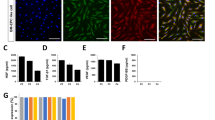Summary
In order to study the effects of exogenous sonic hedgehog (shh) peptide on proliferation, adhesion, migration of endothelial progenitor cells (EPCs) from rat peripheral blood, the mononuclear cells were collected from rat peripheral blood by Ficoll density gradient centrifugation. EPCs were isolated with adherence screening method and cultured in M199 culture medium with the supplement of VEGF and bFGF. The immunohistochemical staining was used to identify cell markers such as CDl33 and VEGFR-2. EPCs were stimulated with exogenous shh peptide of different final concentrations (0.01, 0.1, 1, 10 μg/mL). The proliferation, adhesion and migration of EPCs were detected by MTT chromometry, adhesion test and transwell system, respectively. The results of this study showed that, after 7 days of culture, cells formed clusters, assuming typical cobbles-tone pattern under microscope. After 2 weeks of culture, cells were arranged in cord-like fashion and sometimes grew like “micro-vessels”. Immunohistochemical staining showed that the cultured cells were positive for both CD133 and VEGFR-2. The proliferation, adhesion and migration of EPCs could be promoted by endogenous shh peptide at concentrations from 0.1 μg/mL to 10 μg/mL in a concentration-dependent manner. The findings indicate that exogenous shh peptide can enhance EPCs proliferation, adhesion, and migration, which may have a potential value for clinical application.
Similar content being viewed by others
References
Nishiwaki Y, Yoshida M, Iwaguro H, et al. Endothelial E-selectin potentiates neovascularization via endothelial progenitor cell-dependent and -independent mechanisms. Arterioscler Thromb Vasc Biol, 2007,27(3):512–518
Balaskas N, Ribeiro A, Panovska J, et al. Gene regulatory logic for reading the sonic hedgehog signaling gradient in the vertebrate neural tube. Cell, 2012,148(1–2):273–284
Bahrami SB, Veiseh M, Boudreau NJ. Isolation and expansion of endothelial progenitor cells derived from mouse embryonic stem cells. Methods Mol Biol, 2012, 916:81–96
Huang PH, Chen JW, Lin CP, et al. Far infra-red therapy promotes ischemia-induced angiogenesis in diabetic mice and restores high glucose-suppressed endothelial progenitor cell functions. Cardiovasc Diabetol, 2012,11(1):99
Igreja C, Courinha M, Cachaço AS, et al. Characterization and clinical relevance of circulating and biopsy-derived endothelial progenitor cells in lymphoma patients. Haematologica, 2007,92(4):469–477
Smadja DM, Bièche I, Helley D, et al. Increased VEGFR2 expression during human late endothelial progenitor cells expansion enhances in vitro angiogenesis with up-regulation of integrin alpha(6). J Cell Mol Med, 2007,11(5):1149–1161
Yin AH, Miraglia S, Zanjani ED, et a1. ACl33, a novel marker for human hematopoietic stem and progenitor cells. Blood, 1997,90(12):5002–5012
Zhu Z, Chen G, Li, XR, et a1. Endothelial progenitor cells homing to the orthotopic implanted liver tumor of nude mice. J Huazhong Univ Sci Technol Med Sci, 2012,32(5):675–679
Vasa M, Fichtlscherer S, Aicher A, et al. Number and migratory activity of circulating endothelial progenitor cells inversely correlate with risk factors for coronary artery disease. Circ Res, 2001,89(1):E1–E7
Hill JM, Zalos G, Halcox JP, et al. Circulating endothelial progenitor cells, vascular function, and cardiovascular risk. N Engl J Med, 2003,348(7):593–600
de Groot K, Bahlmann FH, Sowa J, et al. Uremia causes endothelial progenitor cell deficiency. Kidney Int, 2004, 66(2):641–646
Sangidorj O, Yang SH, Jang HR, et al. Bone marrow-derived endothelial progenitor cells confer renal protection in a murine chronic renal failure model. Am J Physiol Renal Physiol, 2010,299(2):F325–F335
Hasebe T, Kajita M, Fu L, et al. Thyroid hormone-induced sonic hedgehog signal up-regulates its own pathway in a paracrine manner in the Xenopus laevis intestine during metamorphosis. Dev Dyn, 2012,241(2): 403–414
Lee JM, Miyazawa S, Shin JO, et al. Shh signaling is essential for rugae morphogenesis in mice. Histochem Cell Biol, 2011,136(6):663–675
Amirpour N, Karamali F, Rabiee F, et al. Differentiation of human embryonic stem cell-derived retinal progenitors into retinal cells by Sonichedgehog and/or retinal pigmented epithelium and transplantation into the subretinal space of sodium iodate-injected rabbits. Stem Cells Dev, 2012,21(1):42–53
Zhou K, Hu C, Zhou Z, et al. Fetal liver stromal cells promote hematopoietic cell expansion. Biochem Biophys Res Commun, 2009,387(3):596–601
Lawson ND, Vogel AM, Weinstein BM. Sonic hedgehog and vascular endothelial growth factor act upstream of the Notch pathway during arterial endothelial differentiation. Dev Cell, 2002,3(1):127–136
Author information
Authors and Affiliations
Corresponding author
Additional information
This project was supported by grants from the National Natural Science Foundation of China (No. 30801099) and Scientific and Technological Projects in Wuhan City (Nos. 201060938360-05, 201051299453).
Rights and permissions
About this article
Cite this article
Zheng, K., Mei, B. Effects of exogenous sonic hedgehog peptide on proliferation, adhesion, migration of endothelial progenitor cells from peripheral blood. J. Huazhong Univ. Sci. Technol. [Med. Sci.] 33, 335–338 (2013). https://doi.org/10.1007/s11596-013-1120-0
Received:
Published:
Issue Date:
DOI: https://doi.org/10.1007/s11596-013-1120-0




